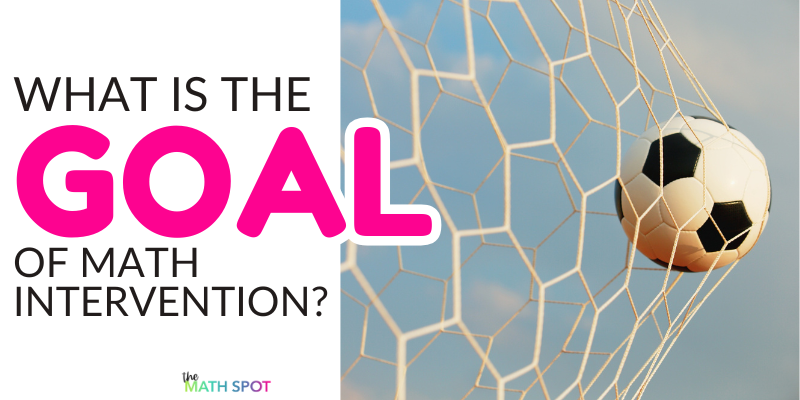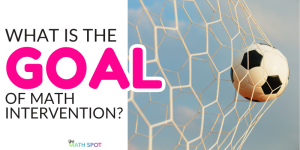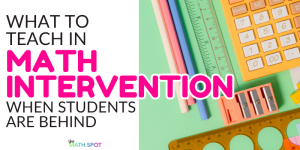Math interventionists walk a fine line every day. On one hand, being responsive to the gaps right in front of you. On the other hand, thinking about where you want your students to be months from now and how today’s choices either move them closer or leave them stuck.
Truly, both matter. And how you strike that balance looks different depending on the grade level you teach.

Kindergarten–2nd Grade: Closing Gaps Early
In the primary grades, your students aren’t that far behind yet. If a first grader is still counting on their fingers or a second grader hesitates on basic addition facts, those gaps feel huge to you as a teacher but there is absolutely still time to catch them up.
It’s a reasonable and very possible goal to bring the majority of your K–2 students up to grade-level expectations by the end of the year. Your planning needs to reflect this target. Of course, you’ll always have students with more significant needs who require additional support or assessment but for the vast majority of your general education students, the end goal should be grade-level by June.
Keeping that target in mind changes how you plan. It keeps you from settling for “almost there” and pushes you to be intentional about the pathway you design.
3rd Grade: A Pivotal Year
Third grade is such an exciting year. It’s the first time students are formally introduced to multiplication and division, and it’s also the year fractions enter the picture.
The beauty of 3rd grade is that, for the most part, no one is really “behind” yet in this new content. Everyone is learning it for the first time. That gives you, as the interventionist, a golden opportunity: if you keep a tight pulse on your students and respond quickly when they start to wobble, you can keep those gaps from ever forming in the first place.
At the same time, you’re still responsible for shoring up any cracks from the primary years. Third-grade intervention has to be efficient and focused so that you can fill holes while also building strong foundations for all the new content that’s coming at them fast.
4th–5th Grade: The Challenge
By the time students reach 4th and 5th grade, intervention becomes more challenging. Every content area (place value, addition and subtraction, multiplication and division, fractions) expands and accelerates. The pace is blistering. Every single gap your students bring with them shows up in big and often frustrating ways.
Sometimes, realistically, you may not be able to get a student all the way back to grade level in one year. But you can get them closer. You can be strategic about the gaps that matter most for upcoming instruction and hit those skills hard before they become stumbling blocks in Tier 1.
That’s where a continuum diagnostic or any systematic tool for pinpointing needs becomes critical- you can’t afford to guess. When you know your students well and plan with their next steps in mind, you give them a fighting chance to enter the next grade closer to expectations than when they walked into your room. That momentum matters.
Why Long-Term Goals Matter
I learned this lesson early in my career as a special education teacher in a 4th-grade integrated co-teach classroom. By the time my students got to me, many of them had significant gaps. I had 4th graders struggling with basic addition strategies. I had students reading at a kindergarten or 1st-grade level.
One of my administrators told me plainly, “One year of growth in one year of time isn’t enough. Your students deserve more.” They went on to explain: “If you only give them one year of growth, they’ll start the next grade just as far behind as they are now. Nothing really changes.”
That perspective shaped everything I did. I set goals for 1.5 years of growth or more.
That mindset carried with me into math intervention. I was never going to just “work on place value” in isolation. I was going to think about the skills ahead, notice what prerequisite skills were needed, and attack those strategically.
What This Looks Like in Practice
For example, when my 2nd graders were preparing to mentally add two-digit numbers using place value strategies, I knew they first needed to confidently solve 10 more/10 less. I built a 5-day pathway from concrete to representational to abstract (mental math), asking predictive questions from day one and linking models together. By day five, they were ready for the mental math expectation not by accident, but because the pathway was strategic.
You might be wondering- why only 5 days? In math intervention, it’s easy to find yourself “working on” a skill indefinitely, never quite moving forward. In Tier 1, the opposite happens: district pacing guides push classes ahead before every student is truly ready, which is one of the reasons gaps form in the first place. In Tier 3, the pendulum swings back with timelines so fluid and responsive that often no concrete pacing exists at all.
By giving myself a 5-day window, I intentionally created urgency. It forced me to be as focused and strategic as possible while still building in opportunities for responsiveness. (And if you know my planning strategy, you know I always leave blank space in the calendar—room to reteach or extend—without sacrificing the overall pace.)
That structure kept my students moving forward and closing gaps while still allowing for pacing that is resposive.
Strategic Planning = Student Success
This is the type of intentional thinking that helps students not just generally “grow” but moving forward toward tangible goals. It’s about balancing the immediate gaps you see today with the long-term goals your students deserve.
When you plan with both in mind, you’re not just patching holes but you are intentionally preventing your students from falling further behind while accelerating them towards where they truly can be!
Math Intervention Resources From The Math Spot









